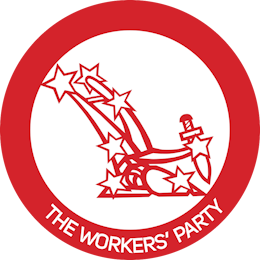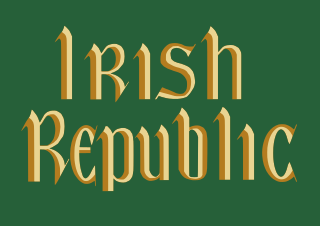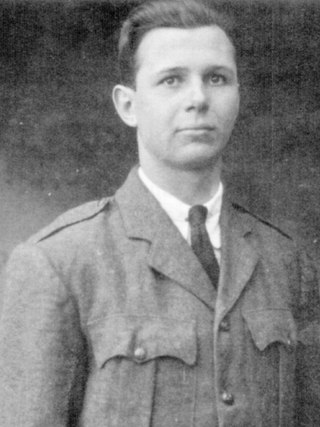Related Research Articles

The Continuity Irish Republican Army, styling itself as the Irish Republican Army, is an Irish republican paramilitary group that aims to bring about a united Ireland. It claims to be a direct continuation of the original Irish Republican Army and the national army of the Irish Republic that was proclaimed in 1916. It emerged from a split in the Provisional IRA in 1986 but did not become active until the Provisional IRA ceasefire of 1994. It is an illegal organisation in the Republic of Ireland and is designated a terrorist organisation in the United Kingdom, New Zealand and the United States. It has links with the political party Republican Sinn Féin (RSF).

Tom Maguire was an Irish republican who held the rank of commandant-general in the Western Command of the Irish Republican Army (IRA) and led the South Mayo flying column.

Na Fianna Éireann, known as the Fianna, is an Irish nationalist youth organisation founded by Constance Markievicz in 1909, with later help from Bulmer Hobson. Fianna members were involved in setting up the Irish Volunteers, and had their own circle of the Irish Republican Brotherhood (IRB). They took part in the 1914 Howth gun-running and in the 1916 Easter Rising. They were active in the War of Independence and many took the anti-Treaty side in the Civil War.

The Workers' Party is an Irish republican, Marxist–Leninist communist party active in both the Republic of Ireland and Northern Ireland.

Republican Sinn Féin or RSF is an Irish republican political party in Ireland. RSF claims to be heirs of the Sinn Féin party founded in 1905; the party took its present form in 1986 following a split in Sinn Féin. RSF members take seats when elected to local government in the Republic of Ireland, but do not recognise the validity of the Partition of Ireland. It subsequently does not recognise the legitimacy of the parliaments of Northern Ireland (Stormont) or the Republic of Ireland, so the party does not register itself with them.

Irish republicanism is the political movement for the unity and independence of Ireland under a republic. Irish republicans view British rule in any part of Ireland as inherently illegitimate. An ideology since the 17th century, various methods have been employed to achieve the republic, including rebellions and paramilitary campaigns. Although the makeup of republicanism has been multidenominational, its relation to catholicism increasingly became central.

Joe Cahill was a prominent figure in the Irish republican movement in Northern Ireland and former chief of staff of the Provisional Irish Republican Army (IRA). He joined a junior-republican movement, Na Fianna Eireann, in 1937 and the following year, joined the Irish Republican Army. In 1969, Cahill was a key figure in the founding of the Provisional Irish Republican Army. During his time in the Provisional IRA, Cahill helped import weapons and raise financial support. He served as the chief of staff in 1972, but was arrested the following year when a ship importing weapons was intercepted.

The 32 County Sovereignty Movement, often abbreviated to 32CSM or 32csm, is an Irish republican group that was founded by Bernadette Sands McKevitt. It does not contest elections but acts as a pressure group, with branches or cumainn organised throughout the traditional counties of Ireland.
Óglaigh na hÉireann, abbreviated ÓÉ, is an Irish-language idiom that can be translated variously as soldiers of Ireland, warriors of Ireland, volunteers of Ireland or Irish volunteers. In traditional Gaelic script, it is written Óglaıġ na hÉıreann.

The Irish Republican Army (IRA) is a name used by various resistance organisations in Ireland throughout the 20th and 21st centuries. Organisations by this name have been dedicated to anti-imperialism through Irish republicanism, the belief that all of Ireland should be an independent republic free from British colonial rule.

The Easter Lily is a badge in the shape of a calla lily flower, worn during Easter by Irish republicans as a symbol of remembrance for Irish republican combatants who died during or were executed after the 1916 Easter Rising. Depending on the political affiliations of the bearer, it can also commemorate members of the pre-Treaty Irish Republican Army, both post-Treaty Irish Republican Armies, and either the Provisional IRA or the Official IRA. It may also be used to commemorate members of the Irish National Liberation Army (INLA).

The Irish Republican Army (IRA) of 1922–1969, an anti-Treaty sub-group of the original Irish Republican Army (1919–1922), fought against the British-backed Irish Free State in the Irish Civil War, and its successors up to 1969, when the IRA split again into the Provisional IRA and Official IRA. The original Irish Republican Army fought a guerrilla war against British rule in Ireland in the Irish War of Independence between 1919 and 1921. Following the signing of the Anglo-Irish Treaty on 6 December 1921, the IRA in the 26 counties that were to become the Irish Free State split between supporters and opponents of the Treaty. The anti-Treatyites, sometimes referred to by Free State forces as "Irregulars",A continued to use the name "Irish Republican Army" (IRA) or in Irish Óglaigh na hÉireann, as did the organisation in Northern Ireland which originally supported the pro-Treaty side. Óglaigh na hÉireann was also adopted as the name of the pro-Treaty National Army, and remains the official legal title of the Irish Defence Forces.

Cumann na mBan, abbreviated C na mB, is an Irish republican women's paramilitary organisation formed in Dublin on 2 April 1914, merging with and dissolving Inghinidhe na hÉireann, and in 1916, it became an auxiliary of the Irish Volunteers. Although it was otherwise an independent organisation, its executive was subordinate to that of the Irish Volunteers, and later, the Irish Republican Army.
Sinn Féin is the name of an Irish political party founded in 1905 by Arthur Griffith. It became a focus for various forms of Irish nationalism, especially Irish republicanism. After the Easter Rising in 1916, it grew in membership, with a reorganisation at its Ard Fheis in 1917. Its split in 1922 in response to the Anglo-Irish Treaty which led to the Irish Civil War and saw the origins of Fianna Fáil and Fine Gael, the two parties which have since dominated Irish politics. Another split in the remaining Sinn Féin organisation in the early years of the Troubles in 1970 led to the Sinn Féin of today, which is a republican, left-wing nationalist and secular party.
Éire Nua, or "New Ireland", was a proposal supported by the Provisional IRA and Sinn Féin during the 1970s and early 1980s for a federal United Ireland. The proposal was particularly associated with the Dublin-based leadership group centred on Ruairí Ó Brádaigh and Dáithí Ó Conaill, who were the authors of the policy.
Irish republican legitimism denies the legitimacy of the political entities of the Republic of Ireland and Northern Ireland and posits that the pre-partition Irish Republic continues to exist. It is a more extreme form of Irish republicanism, which denotes rejection of all British rule in Ireland. The concept shapes aspects of, but is not synonymous with, abstentionism.
Dissident republicans are Irish republicans who do not support the Northern Ireland peace process. The peace agreements followed a 30-year conflict known as the Troubles, in which over 3,500 people were killed and 47,500 injured, and in which republican paramilitary groups such as the Provisional Irish Republican Army waged a campaign to bring about a united Ireland. Negotiations in the 1990s led to an IRA ceasefire in 1994 and to the Good Friday Agreement of 1998. Mainstream republicans, represented by Sinn Féin, supported the Agreement as a means of achieving Irish unity peacefully. Dissidents saw this as an abandonment of the goal of an Irish socialist republic and acceptance of partition. They hold that the Northern Ireland Assembly and Police Service of Northern Ireland (PSNI) are illegitimate and see the PSNI as a British paramilitary police force.

Proinsias Mac Airt was an Irish republican activist and long-serving member of the Irish Republican Army.

Michael Flannery was an Irish republican who fought in the Irish War of Independence and the Irish Civil War. He supported the Provisional IRA during The Troubles and was a founder of NORAID and Cumann na Saoirse after Republican Sinn Féin and Provisional Sinn Féin split in 1986.
References
- 1 2 Bowyer Bell, J. (1997). The Secret Army: The IRA. Transaction Publishers. p. 337. ISBN 1-56000-901-2.
- 1 2 3 Taylor, Peter (1997). Provos The IRA & Sinn Féin. Bloomsbury Publishing. p. 380. ISBN 0-7475-3818-2.
Whereas I use the Republican Movement as the generic name for the 'Provos' - the Provisional IRA and Sinn Féin - the term the 'Movement' is used by republicans to mean the IRA.
- 1 2 O'Donnell, Ruán (2012). Special Category: The IRA in English Prisons Vol.1: 1968-78. Irish Academic Press. p. xiv. ISBN 978-0-7165-3142-5.
Republican Movement: Collective term for the IRA, Cumann na mBan, Sinn Féin, National Graves Association, republican youth and marching bands which emerged from the 1969/1970 split
- ↑ 'No Irish model for Palestinians', Henry McDonald, The Guardian, 26 January 2006
- ↑ O'Donnell, Ruán (2012). Special Category: The IRA in English Prisons Vol.1: 1968-78. Irish Academic Press. p. xiii. ISBN 978-0-7165-3142-5.
Official Republican Movement: Collective term for the Official IRA, Official Sinn Féin, Official Na Fianna Éireann and allied republican groups following the 1969/1970 split
- ↑ Morrison, John F. (2015). The Origins and Rise of Dissident Irish Republicanism. Bloomsbury Publishing. p. 85. ISBN 978-1501309236.
This chapter covers the relatively short process which resulted in the division in the Official Republican Movement resulting in the formation of the Irish Republican Socialist Movement (IRSM) which consisted of an armed wing, the Irish National Liberation Army (INLA) and a political wing, the Irish Republican Socialist Party (IRSP)
- ↑ The Omagh Bombing: Some Remaining Questions Fourth Report of Session 2009-10 Report, Together with Formal Minutes, Oral and Written Evidence (House of Commons Papers). Stationery Office Books. 2010. p. 10. ISBN 978-1501309236.
Although the Belfast Agreement was signed on Good Friday in April that year, the dissident republican movement, principally through the Real IRA and the Continuity IRA, continued to be active.
- ↑ Jackson, George (22 April 2014). "Dissident republican criticises Martin McGuinness's toast to queen". The Irish Times . Retrieved 10 February 2020.
- ↑ Taylor, Max (2011). Dissident Irish Republicanism. Continuum. pp. 53–54. ISBN 978-1441154675.
It also confirms that the seemingly large contingent from the South is not biased by data collection on members from the wider dissident movement that do not necessarily engage in the violence itself (e.g. Republican Sinn Féin).
- ↑ Morrison, John F.; Busher, Joel (2018). "Micro Moral Worlds of Contentious Politics: A Reconceptualization of Radical Groups and Their Intersections with One Another and the Mainstream". Mobilization . 23 (2): 9. doi:10.17813/1086-671X-23-3-219. S2CID 149187634.
The relationship between RSF and CIRA is however difficult to unpick. It is publicly known, and privately acknowledged, that RSF is the political wing of the CIRA, with the two organisations sometimes collectively referred to as the Continuity Republican Movement.
- ↑ Horgan, John (2013). Divided We Stand: The Strategy and Psychology of Ireland's Dissident Terrorists. Oxford University Press. pp. 139–140. ISBN 978-0-19-977285-8.
Similarly, the RIRA and 32 County Sovereignty Movement (32CSM) can be combined to show the membership of the Real Republican Movement.
- ↑ Coogan, Tim Pat (2000). The I.R.A. HarperCollins. p. 257. ISBN 978-0006531555.
- 1 2 Dillon, Martin (1992). Killer in Clowntown: Joe Doherty, the IRA and the Special Relationship. Hutchinson. p. 171. ISBN 0-09-175306-6.
Some might even be members of the republican movement, a term used broadly to define all the groupings, the IRA included, who shape and promote the republican idea of a United Ireland, with the specification that the 'armed struggle' of the IRA is central to achieving that ideal. Therefore the umbrella term 'republican movement' is politically and intrinsically linked to the IRA. Not all those within the republican movement, whether they be members or supporters of the political party Sinn Féin, are necessarily volunteers in the IRA
- 1 2 3 Dillon, Martin (1992). Killer in Clowntown: Joe Doherty, the IRA and the Special Relationship. Hutchinson. p. 24. ISBN 0-09-175306-6.
'Republican movement' is a euphemism to cloak the illegality of all those proscribed IRA organisations which come under that umbrella term, such as Na Fianna Éireann, the Irish Republican Army and Cumann na mBan (the women's grouping). It is not unlawful to be a republican or to express the republican aspiration that Ireland should be unified. Therefore members of those organisations which are illegal use the term 'republican movement' to mask their true affiliations
- ↑ "CAIN: Issues: Politics: Sinn Fein (1979?) New Members Course: Notes for Sinn Fein education officers - Republican Lecture Series".
- ↑ White, Robert (2017). Out of the Ashes: An Oral History of the Provisional Irish Republican Movement. Merrion Press. p. 201. ISBN 9781785370939.